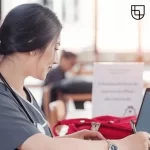Ubiquitous Learning, also known as U-learning, is a relatively young field in which different disciplines converge, such as education, pedagogy, psychology, computer sciences, information and communication technology, and cognitive sciences. The learning process includes real-life experiences augmented with virtual information and is adapted to the learner and the learner’s environment.
The U-learning process is tailored to the learner’s goals, interests, cognitive characteristics, location, technology, and context, ensuring personalized content, activities, and interaction with instructors and peers. Defined as an everyday learning environment supported by mobile and embedded computers and wireless networks in daily life (Ogata et al., 2009), U-learning aims to provide learners with content and interaction anytime and anywhere (Hwang et al., 2008).
In simple words, Ubiquitous learning refers to a process where students can access education from anywhere around the globe at any time. A big thanks to Information and Communication Technologies – because of this, access to learning is easily integrated into daily activities.
Characteristics of Ubiquitous Learning
Let us explore the characteristics that make ubiquitous learning enable seamless and pervasive educational experiences for students.
Ease of Access
As mentioned, U-learning is easily accessible to students from anywhere, anytime, requiring a reliable internet connection. It also keeps you mobile without hindering learning. The easy access to information from anywhere at any time makes it inclusive, as it removes all physical and geographical barriers to information access, whether for work or personal use. For example, a student uses a smartphone app to scan QR codes in a museum, enabling them to access multimedia information about the exhibits.
Highly Adaptive
Regardless of the features of the knowledge community a student belongs to, ubiquitous learning adapts to their learner profiles and makes content customization easier. E.g., an enthusiast for learning English can record and analyze their speech with a mobile app that adjusts to their level, goals, preferences, and progress while offering personalized comments and ideas. Additionally, the application can adapt to the device’s features, making learning more efficient.
Interactive in Nature
Engaging in interactive activities inspires both students and teachers. Bidirectional communication fosters new teaching channels, allowing for proactive error identification and correction and realistic, reactive teaching methods.
Rapid Response
Rapid access to data and answers shortens the time required to look into a subject and enhances the absorption of information.
Informality
Informal learning occurs in the learner’s settings, free from the constraints of rigid contexts or the need to adhere to social norms.
Limitations of Ubiquitous Learning
Here are some limitations that can make Ubiquitous Learning challenging:
Sources Authenticity Issue
Identifying authentic sources might be challenging as various websites contain identical content. Additionally, manuscripts and theses may be altered often, requiring trust only in the information produced by hand or published by a reputable institution and including fundamental research and supporting data.
Insufficient Information
One may believe that the internet, the most extensive library ever, is filled with information on almost everything; it must have comprehensive knowledge of all subjects. However, the internet world sometimes covers small details regarding a topic or issue. To learn thoroughly, sometimes, it may be better to depend on traditional libraries.
Lack of Practical Knowledge
Not only does practical knowledge improve your chances of landing a job, but it also sharpens your abilities. For this reason, research in laboratories is required in high schools and colleges. You can become theoretically sound through books and the internet, but you will need to learn everything in real life to use your studies and acquire practical skills in the workplace.
Lack of Discussion
In a traditional classroom, where group discussions or debates are held, learners can discuss topics and conclude them. It facilitates a brainstorming process that aids in keeping the environment competitive and academic. Additionally, if students need clarification about any provided information or learning, they may ask the teachers and colleagues for help.
Here is a video of Dr. Bill Cope and Dr. Mary Kalantzis explaining the concept of Ubiquitous learning, defining the term, and explaining why you should consider it.
Hence, to make the most of the diverse learning flexibility offered by Ubiquitous Learning, it is essential to tackle challenges such as source authenticity, integrating real-world experiences, blending online and conventional materials, and encouraging discussion. A comprehensive strategy incorporating technological advancements, experiential learning, active participation, and cooperation can significantly improve and support learning.

